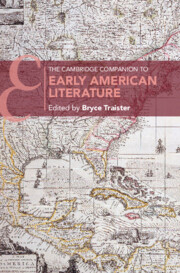Book contents
- The Cambridge Companion to Early American Literature
- The Cambridge Companion to Early American Literature
- Copyright page
- Contents
- Figures
- Contributors
- Introduction
- Part I How to Read (in) Early America
- Part II Readings in Early America
- 7 Accident, Disaster, and Trauma
- 8 Settler Kitsch
- 9 Like a Prayer
- 10 Varieties of Bondage in the Early Atlantic
- 11 The Erotics of Early America
- Part III Early American Places
- Select Bibliography
- Index
- Cambridge Companions To …
7 - Accident, Disaster, and Trauma
Shattered in Early America
from Part II - Readings in Early America
Published online by Cambridge University Press: 18 November 2021
- The Cambridge Companion to Early American Literature
- The Cambridge Companion to Early American Literature
- Copyright page
- Contents
- Figures
- Contributors
- Introduction
- Part I How to Read (in) Early America
- Part II Readings in Early America
- 7 Accident, Disaster, and Trauma
- 8 Settler Kitsch
- 9 Like a Prayer
- 10 Varieties of Bondage in the Early Atlantic
- 11 The Erotics of Early America
- Part III Early American Places
- Select Bibliography
- Index
- Cambridge Companions To …
Summary
Although English settler colonialism was ascendant in the seventeenth- and eighteenth-century Americas, its literature was often written as disaster. This chapter considers three modes of catastrophe – accident, disaster, and trauma – to argue that the violent forces and harsh conditions of life in the New World fragmented former identities and that coloniality emerged from that shattering. The story of accident is told through Jamaican creole Jonathan Dickinson who, along with his small crew of family, friends, shipmen, servants, and slaves, were shipwrecked en route from Port Royal to Philadelphia in 1696. They landed in Florida, where their accidental arrival led them to impersonate the Spanish, to provoke enmities with Indigenous people over both their feigned and their real identities, and to desperately improvise their way over 230 miles to rescue. The story of disaster is told through early Jamestown, a site where extreme suffering and violence compounded to guarantee dire outcomes. For the small number of settlers who survived, their Englishness did not survive within them. From the Starving Time to the First Anglo-Powhatan War, their coloniality took shape in a space of abjection and aggression, marking settlement as a theater of brutality and horror. Trauma is recounted through the narrative of the Pequot War and the life of Mary Prince. These stories of unbridled warfare against the Pequot of New England and the un/common trauma inflicted on enslaved people of the Caribbean bear testimony to the radical dispossession white colonials inflicted upon Native and enslaved people, and the struggle to maintain identities in this context. Together, attention to accident, disaster, and trauma ruptures any smooth accounting of colonial “development” and instead testifies to the tearing, sundering, and shattering that make this history remain uneven, unsteady, and unresolved.
Keywords
- Type
- Chapter
- Information
- The Cambridge Companion to Early American Literature , pp. 117 - 131Publisher: Cambridge University PressPrint publication year: 2021

